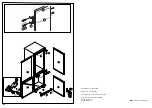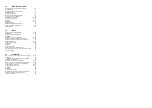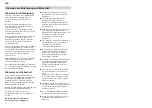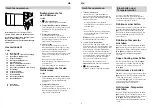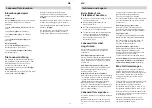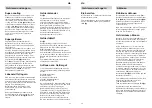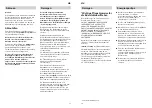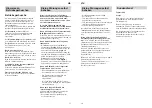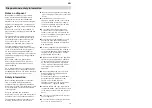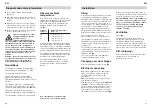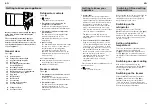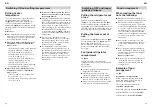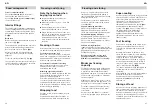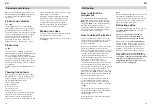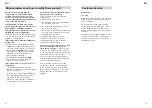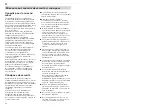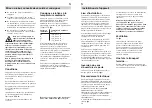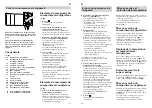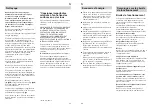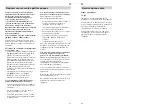
25
en
24
en
Setting freezer
temperature
To do this, hold down or repeatedly press
the temperature selection button
0
C
(Fig.
2
/5) until the desired temperature is
set. The corresponding temperature is
lightened (Fig.
2
/6). We recommend setting
the temperature of the freezer compartment
at -18
0
C.
Please note:
l
If the temperature selection button of the
refrigerator or the freezer compartment is
not pressed for 5 seconds, the currently
selected temperature is saved.
l
Excessively warm temperatures in the
refrigerator or freezer compartment
may occur if...
- the doors has not been closed property
- fairly large quantities of warm food
have been placed in the appliance.
- the temperature selectors have been
set to +8
0
C and -16
0
C.
- the air circulation in the refrigerator or
freezer compartment is severely
impeded by the stored food.
- the doors have been opened frequently
at high ambient temperatures.
l
Excessively cold temperatures in the
refrigerator or freezer compartment
may occur if...
- “super-cooling” or “fast freezing” has
been switched on.
- the temperature selectors have been set
to +2
0
C or -32
0
C.
l
To prevent condensation in the area of
the door seal, the sides of the housing
are partially heated.
l
While the refrigerating machine is running,
water droplets of frost will form on the rear
panel of the refrigerator, simply caused by
the refrigerating machine functioning. It is
not necessary to scrape off the frost or
wipe off the water. The rear panel defrosts
automatically. The defrosting water
collects in the gutter (Fig.
9
/B), and then
routed to the refrigerating machine where
it evaporates.
l
You may notice that the door of the
freezer sometimes refuses to open again
directly after having been closed. If this
does happen, wait two or three minutes
for the vacuum to equilibrate.
l
The refrigerating system may causes
some areas of the freezer grids to ice up
quickly. This, however, does not affect the
functioning efficiency of the appliance or
power consumption. Defrosting is only
necessary once over 5 mm of frost or ice
has built up over the entire area of the
freezing grid.
Putting the refrigerator out
of use
Press the refrigerator ON/OFF switch
(Fig.
2
/1). The temperature light (Fig.
2
/3)
will go out, indicating that the refrigerator
and lighting of the entire appliance has been
switched off. Clean the interior and leave the
door open to prevent any unpleasant smell.
Putting the freezer out of
use
Press the freezer ON/OFF switch (Fig.
2
/9).
The temperature light (Fig.
2
/6) will go out.
Defrost and clean the freezer.
We recommend wiping the interior dry as
well as the freezing grids and leaving the
door open.
Fan inside refrigerator
compartment
Fig.
1
/10
The fan at the top of the refrigerator
compartment increases the speed at which
air circulates.
The results are...
l
a uniform temperature throughout the
refrigerator compartment
l
after the door has been opened, the
original temperature is restored rapidly
l
when the temperature setting is altered,
the new level is reached more quickly
l
fresh food can be kept for a longer period
of time due to decreased air humidity.
Switching ON and setting temperatures
Switching OFF and longer
periods of disuse
Food arrangement
When loading the food,
note the following:
l
Allow warm food and beverages to cool
down before storing inside the appliance.
l
Ensure that food is well wrapped or
covered before it is stored. This will pre-
vent food from dehydrating, deteriorating
in colour or losing in taste and will help
maintain freshness. It will also prevent
cross-flavouring. Vegetables, fruit and
salad need not be wrapped provided they
are stored in the vegetable bins of the
refrigerator.
l
Never let any oil or grease come into
contact with plastic fittings or the door
seal as these materials easily become
porous.
l
Never store any explosive substances
inside the appliance. High-proof alcohol
should only be stored upright in tightly
sealed containers.
Danger of explosion!
l
Glass bottles containing liquid that can
freeze should never be stored in the
freezer as the glass bursts when the
contents freeze.
Example of food
arrangement
Fig.
1
Refrigerator compartment (A)
Bread, cakes and pastries, ready-made
meals and dairy products, from top to
bottom on the
shelves (11)
.
Fruit, vegetables and salads in the
vegetable container (15)
.
Butter and cheese in the
compartment (16)
.
Small bottles and cans on the
shelf (17)
.
Large bottles on the
bottle shelf (20)
.


